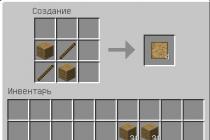The rain staff or rain flute (reinstick, hmara) is a special instrument that was originally used by the tribes of Africa and Indonesia in order to establish contact with the spirits of Water. It was made from a hollow tube (stem of a dry plant), into which grain was poured. It created the effect of overflowing water and imitated the sound of rain or a waterfall.
You can make this simple and so magical and bewitching instrument with your own hands (you will find its sound below).
What to make a staff of rain
Most the best option- dry stalk of hogweed or angelica. The thicker and longer it is, the more effective the instrument will be - the “water” will overflow for a very long time. Another option is thick bamboo. It will be slightly muffled due to the thickness of the walls, but more reliable (even if you accidentally step on it). If you do not have natural material, you can use a cardboard tube or even a sheet of cardboard folded into a roll.
What you need

- awl or drill (if you work with bamboo),
- scissors,
- toothpicks,
- several types of dry cereals (lentils, rice, buckwheat),
- PVA glue,
- cardboard, pieces of leather,
- sandpaper.
Progress
1) We pierce the wall of dry grass along the entire length of the tube in a spiral (in our case it is angelica). Step 1 cm.

Between the turns of the spiral we make another spiral (2 or more are possible). The closer the coils are to each other, the longer the staff will sound.
 2) Now we take the toothpicks and thread them through one designated hole, and with the other end we pierce the opposite wall of the stem so that the stick passes just in the middle of the cavity.
2) Now we take the toothpicks and thread them through one designated hole, and with the other end we pierce the opposite wall of the stem so that the stick passes just in the middle of the cavity.


This is a rather long and meditative process. You will have to tinker with bamboo a little longer, drilling holes of the desired diameter with a drill.
The result is such a "mace" - a cactus.

3) Now, with scissors or side cutters, carefully cut off the ends of the toothpicks.

4) The resulting "stumps" are sanded with sandpaper.
 5) We coat the entire stem with PVA glue (to fix the result).
5) We coat the entire stem with PVA glue (to fix the result).

6) Now we glue a cardboard flap on one end of the tube so that the grains do not spill out.
 7) Hurrah! Now the most interesting ... We fall asleep inside the cereal (lentils, peas, rice, buckwheat). It is better to fall asleep different-sized cereals so that the sound has many shades.
7) Hurrah! Now the most interesting ... We fall asleep inside the cereal (lentils, peas, rice, buckwheat). It is better to fall asleep different-sized cereals so that the sound has many shades.
It's great when so many craftswomen get together! New creative ideas, original solutions, pleasure from the process, and as a result, so much extraordinary beauty at once!
At first it was not easy. Many of you have tried the kimekomi technique for the first time, and there were difficulties in making balls, sometimes it was not possible to find the necessary materials, or it was simply not possible to get out to the store. But if we want to do something wonderful, nothing will stop us, right? And it was very interesting to read your stories about how, not being able to get out to the store, you made balloons from stocks of tapes, and even from pieces of clothing, how difficult it was to photograph the balloons, since the sun does not spoil us at this time of the year, like you worried about not being able to find the next step in the project. I enjoyed reading Olga Helga-Cat's story about how she managed to finish the set before it was published. last master class. And it was also very joyful to read reports on how children master this outlandish technique.
Let me tell you, it wasn't easy for me either. During the project, I received more than 200 letters from you, I answered almost all of them :)) And every time I looked forward to new photos with your work, and you never ceased to amaze me :))
Just think, all together you made about 170 balls - and these are only the ones you wrote to me about, in fact, I'm sure there are many more!
And of course I love ALL your balls! It is incredibly difficult to choose the best, because they are all good in their own way :) Someone likes shiny and elegant, someone bright and juicy, and someone likes restrained and elegant. The taste and color .. you know)))
And I chose to my taste, of course :) But I couldn’t choose one winner, so the first place was divided by sets

The winners will receive from me as a gift cuts of New Year's fabrics, foam blanks, ribbons, beads, buttons, bells.

For Natalia, I prepared my book with an autograph.
I would also like to highlight the balloons of Katya Okatava - a wonderful color scheme, an amazingly elegant set by Maria Kokina, exquisite balloons by Tatyana Bork and Veronica. Inna Yaakkola and Tatyana Trukhanovich made very interesting balloons with pictures.
I liked the unusual balls of Natalia Slonik, made in the kaleidoscope technique according to the second master class. And the bright sets of Elena Malinina and Evgenia cheer up.
Angelica forest
Many have seen tall plants in the summer with white umbel inflorescences on thick, hollow stems. This is an angelica. It was named so not by chance - pipes were made from its stems, because the stem of the angelica is a ready-made flute, just make holes. Angelica stalks are also suitable for many other things - earlier candles were cast in them (this is a ready-made mold for casting), they were used as a breathing tube under water, and we use them as cases for knitting needles or pencil cases, and also as convenient boxes for storing spices or other suitable materials. Once angelica was useful to us even as an envelope.
spice boxes
stems of angelica
Making a case is very easy. Look carefully at the angelica stem - it is not even, but divided into separate tubes, as if glued together at different angles. And at the junctions of these tubes (at the nodes), the stem is full-bodied, and the tubes themselves are empty inside. Therefore, the nodes are ready-made bottoms, you just need to carefully saw off the stem below the node, and that's it. The cuts - both the lower and the upper ones - need to be cleaned with sandpaper (sandpaper), and the stem can also be cleaned with it. The knife blade also copes well with such cleaning, if you hold it at a right angle to the surface to be cleaned.
knots on angelica stems
Now that you know exactly what you need to do, it's time to go get the angelica. It grows in wet meadows, on forest edges, in thickets of willow or alder. You can collect angelica at any time of the year, even in winter, if you do not get tired of climbing snowdrifts. In early spring, you can collect overwintered stems of a beautiful gray-brown color, in summer or autumn - soft green. The stems need to be dried, then sawn and cleaned, and then decorated.
Wrap the upper part of the case for strength and beauty with a thick thread or cord
knitting case
rum, putting it on glue. Then make a plug from any material - wood, birch bark cork ... And finally - paint. Just don't forget that although angelica looks like bamboo, it is much less durable: if you accidentally step on the stem with your foot, crush it, so it's best to store the cases somewhere in a drawer or hang them on the wall. Well, if the case is still broken, it doesn’t matter - nature will grow a new one.
overwintered stems of Sakhalin rheinutria
rum angelica for boxes and cases are suitable stalks of rheinutria sakhalin(the old name is the Sakhalin highlander) and the famous hogweed Sosnowski, whose dry stems are wide, strong and not at all dangerous. If you collect cow parsnip in the summer, do it with gloves and in cloudy weather, because. its juice contains photosensitizing substances that cause severe and long-lasting burns on the skin under the influence of the sun. Is there some more siberian hogweed, native to Central Russia and not a dangerous plant at all, but it is smaller than Sosnovsky's hogweed.
painted blank
Beautiful pencil cases. You can make them with children, but older ones can do it on their own, great, it seems to me that it will be very interesting!
Is it possible to confuse angelica and Sosnovsky's cow parsnip with similar poisonous plants? How to distinguish them, especially in winter? ..
Do you paint with anything, acrylic, gouache, oil?... Do you varnish from above?..
Sosnovsky's hogweed in dry form is not at all dangerous, while other types of hogweed are edible. Eaten for a long time in kitchens different peoples. Angelicas are not poisonous either.
You can distinguish cow parsnip externally. B. sosnovsky stands out for its growth, often exceeding 2 meters. It grows in very large groups (populations) mainly along roads and in weedy places, as it is an alien species.
We paint crafts from angelica with acrylic without varnishing.
I just remember something from my childhood - it was impossible to make pipes out of some cow parsnip, and therefore the ban automatically extended to cow parsnip in general. :-) Despite the fact that they read that the plant is very useful and edible.
Pencil cases are certainly not for eating. :-)) Something Indian reminds...
In the same family (umbrella), in addition to Sosnowsky's hogweed, there are other poisonous plants - milestones (hemlock) and hemlock. They are rare and easy to confuse with angelica. But even their rhizomes are poisonous, not the stems. And the fear of poisoning with pipes is only from general botanical illiteracy: unfortunately, people know very little about the plants among which they live, and with the flow of people to cities, everything has become even more deplorable ...
And that the pattern resembles something Indian is very nice to hear, because it was intended that way :)
Illiteracy is such a thing ... you start to be afraid of everything, not a step to the right or left - there are dangers everywhere. :-)))
We have a lot of umbrella plants growing here, some of them are near the river, in swampy places, some are higher. About those that are taller they say that this is hemlock, but I looked at the directories a lot - it seems not to be him, but I can’t establish for sure. :-)
It's good that you can easily make crafts from them. Children really like sticks-pipes.
Conversation with real Upper Volga artisans to the sounds of exotic musical instrument with the beautiful name "Rain Flute" - this is how the editors of TIA began Monday morning. Craftswoman Elena Boriskova cordially welcomed the guests in her house in the village of Kushalino and held a real handicraft master class. The highlight of the program was the hated and ubiquitous poisonous plant - hogweed. Surprisingly, it is from it that the needlewoman creates her flutes.
Elena spoke about the history and ethnicity of this unusual musical instrument:
- It was used by the shamans of ancient Africa, Indonesia, and Latin America to bring rain and control thunderclouds. Of course, I already give it a slightly different meaning: it is relaxation, interior decoration, gifts to friends and family. I make a lot of flutes and then give many of them as gifts.
Elena picked up her largest Rain Flute, turned it over like hourglass, and at that moment a miracle happened: the room was filled with real sounds of water - it seemed that thousands of small drops were flowing somewhere in the stream.
In fact, of course, there was no water in the dry trunks of the burning giant plant, but only hundreds of seeds falling down and passing through a maze of toothpicks on their way.
The craftswoman said that although the hogweed is famous as a dangerous plant that can cause serious burns, if you collect it wisely, then nothing bad will happen.
- Hogweed juice is dangerous, therefore, for creativity, the plant must be collected dry, that is, either in late autumn, or even last year, then it does no harm.
The process of preparing hogweed stems for future flutes is laborious, because the plant can often be dirty, then it has to be washed in the shower and cleaned - Elena does this with a hard metal brush. Then she dries the stem, which, by the way, is hollow inside, makes holes in a spiral, and inserts ordinary toothpicks into them. This is followed by filling the tool with various cereals or seeds, and then the most pleasant part of the work is decorating.
- A lot of toothpicks go away and cereals too. But I take different decorations, but always natural: pebbles, all sorts of feathers. I fill the flute in different ways - I determine by ear so that I like the sound. Sometimes I fill it up, then I don’t like it, then I pour everything out and start over. The sound of the flute depends on the thickness of the stem, its length, on how far toothpicks are inserted from each other and, most importantly, on the filler - millet gives a rustling effect, peas sound booming. Buckwheat has a very beautiful sound, I use it often.
Elena has been making Rain Flutes for about 9 years. She told how she accidentally saw this instrument at a city holiday and decided to make the same one herself.
- How exactly that hogweed made noise, I didn’t really understand then, at home I started to try it at random. I did my first work without jumpers, without these toothpicks, I decorated it, and then I realized that it somehow didn’t sound right and I didn’t like it. Later, by trial and error, I figured out exactly how best to do it. And even later, I saw all this on the Internet many times and made sure that you really need to pierce the stem inside. But as for decorating - this is purely my imagination, I decorate as my heart desires, I really love jute and other natural materials, so that everything is natural.
It is interesting, but, according to Elena, not everyone can hear the sounds of water in the rustle of spilling seeds.
- For some reason, children always hear the sea. But in adults, everyone has their own way, someone does not hear anything at all. I personally hear water, rain and sea.
The family supports Elena's hobby. She said that she collects materials with her son, however, he is not very willing to participate in the work, but he helps to make blanks, cleans the cow parsnip, for example.
By education, Elena is a garment production technologist, she came to the Tver region with her family in 2004 and it was here that she devoted herself to creativity.
- I never worked in my specialty - I always sewed to order, also creative work I had. And when we arrived in the Upper Volga region, here I was finally, what is called "flooded" on creativity. There is such a Nadezhda Novozhilova in Tver, she is engaged in gold embroidery, I studied with her, I have a diploma and even work in the church - real church embroidery. I was also engaged in beadwork, I also make flowers from fabric. A little bit of everything, in general. Especially now, when so many interesting things in the field of needlework can be seen on the Internet: both dolls and flowers - I want to try everything.
In addition to Rain Flutes, the needlewoman also demonstrated cow parsnip maracas, hand embroidery, corn leaf dolls, organza flowers, jute Dream Catchers, and even a cat house made of cardboard.
Elena's friend Tatyana Popova is also a needlewoman, she makes intricate ethnic jewelry from beads and stones. Tatyana spoke about how she accidentally became addicted to these multi-colored small beads and pebbles:
 - It all started with my daughter's interest in beads. Then I, helping her, got carried away, and almost immediately chose the ethnic direction, because it is very interesting. Such decorations go with everyone and are combined with almost any clothing - this is their special charm.
- It all started with my daughter's interest in beads. Then I, helping her, got carried away, and almost immediately chose the ethnic direction, because it is very interesting. Such decorations go with everyone and are combined with almost any clothing - this is their special charm.
The friends are sure that interest in ethnic crafts and national needlework must be revived among the younger and rising generations. In the future, they and other fellow villagers want to organize creative circles and teach in them. Tatyana's husband, a person with an art education, for example, said that he could teach painting on wood. By the way, he made a list, where he listed all the crafts and other disciplines, the employment of which among young people would benefit the culture of the Tver region.
In addition to embroidery, beadwork, pottery, sculpture, forging and much more, even local history and hiking were on the list. At the same time, enthusiasts are sure that there are such masters in the villages and cities of the Upper Volga region and, if possible, they will gladly take up the training of children.
If you find an error, please select a piece of text and press Ctrl+Enter
We are in touch Viber or WhatsApp +79201501000
The use of natural material as an object of labor provides unique opportunities: the use of environmentally friendly raw materials, which are also surprisingly beautiful and, most importantly, do not require a mat.
Completed by technology teacher Savelyeva T.V.
Participants of the 9th grade student project:
Dudko Daria
Shchedrova Alexandra
Rationale
The use of natural material as an object of labor provides unique opportunities: the use of environmentally friendly raw materials, which are also surprisingly beautiful and, which is important, do not require material costs. Working with natural materials brings positive energy, and almost every product is unique and original in its own way.
Target.
Organization of independent creative work.
Learn to use natural material (hogweed) in folk art. . Make an original vase from hogweed and other decorations. Such a vase will be a nice gift for acquaintances, relatives and friends.
Tasks
Improve your knowledge about natural materials for crafts.
Develop skills in working with hogweed.
- To study the stages of development of Sosnowski's hogweed and determine the safest period for collecting material.
- Learn to process the collected material.
Estimated result
Formation among students of friendly, benevolent relations, mutual assistance, camaraderie in the organization and work on the project
Deadlines
March 2014
Content
Bank of ideas and suggestions.
Identification of the main requirements for the product.
Collection of information on the subject of the project.
- Technological stage
Selection of materials, tools and
fixtures
- The final stage
Making a vase.
- Organizational and preparatory stage
Bank of ideas and proposals
First you need to choose a sample crafts from hogweed. After reviewing a lot of literature and sites on the Internet, we did not find many options. Therefore, we have come up with the proposed options ourselves. We initially settled on two options.
The first is a pencil holder and the second is a vase. We decided to focus on vases, it seemed the most interesting, and leave the pencil holder for another time.
Identification of the main requirements for the product.
When designing an object, one should take into account the assembly sequence, beauty, organicity and integrity of the external form, harmony. All operations must be carried out with great care. A prerequisite is the use of environmentally friendly materials.
My product must meet the following requirements:
aesthetic - the vase should be beautiful and bright. The product design must be original.
environmental - the product must be made of environmentally friendly materials, in the manufacture of it there should be as little waste as possible.
economic - the product must be made from affordable, waste, inexpensive materials and have a low cost;
operational - the vase must correspond to the purpose;
technological - technological operations for the manufacture of the product must be rational, safe, accessible.
Collection of information
From the history
The migration of plants and animals as a result economic activity a long-standing and serious environmental problem. When in the 1960s Sosnovsky's hogweed was brought to our country for cultivation as a fodder crop, no one imagined that this stranger from the Caucasus would behave so aggressively and turn into a real environmental disaster. It persistently threatens not only natural ecosystems, but also human health. But you can use this material for crafts.
Let's try to find out how you can use hogweed in creativity most effectively.
- Technological stage
Selection of materials, tools and fixtures
To make a vase from hogweed, we need:
The bottle is plastic;
cow parsnip;
Shells of various shapes
aquarium sand
Glue "Titan"
Varnish on wood
Workplace organization and safety.
When working on the vase and in order to save life and health, we followed and observed all the necessary safety and labor protection rules.
When doing manual work.
1.Before starting work: prepare all the necessary materials and fixtures; stationery knife, kitchen knife, sandpaper, scissors, tools and accessories put in a separate place for them.
- During work: be attentive to work; put the knife and scissors to your right with closed blades; pass the scissors only with closed blades and rings forward, and the knife with the handle forward.
- Upon completion of work: clean the workplace.
Collection and processing of material
Cutting hogweed at a young age is dangerous because of the poisonous juice that gets on the skin and causes burns, but is effective if the work is done in the fall (September-November), when the plant is already dry. Hogweed is cut off already dry, cut into certain segments or plates and polished.
Economic justification
|
Subject |
Price |
|
|
hogweed |
____ |
|
|
Lemonade bottle |
0 rubles |
|
|
Shells of various shapes |
____ |
|
|
Twine |
20 r |
|
|
aquarium sand |
20r |
|
|
Glue "Titan" |
60 rubles |
|
|
Varnish on wood |
80 rubles (1/6 part-13r) |
|
|
Result: 73 rubles. |
||
The final stage
Making crafts
We cut and grind the cow parsnip.
Cut off the throat of the bottle. Then we attach the hogweed to the bottle, holding it with our hands.
Wrap with twine or elastic and leave to dry.
Spread the gaps between the hogweed with glue and stick long-shaped shells.
We decorate the gaps between the shells with aquarium sand.
We process the edges with the same aquarium sand.
Let's start decorating the vase. With the help of shells we make flowers and butterflies.
This is how we got an excellent vase that can be presented for any holiday!
Resource support
1. Gubanov I. A. et al. Illustrated guide to plants in Central Russia. 2. Maidenova I.P. Caucasian species of the genus Heracleum, Tb., 1950.
4. The Tale of the Hogweed. Part 1, 2008 Kanasheva L.
5. site www.myjane.ru














